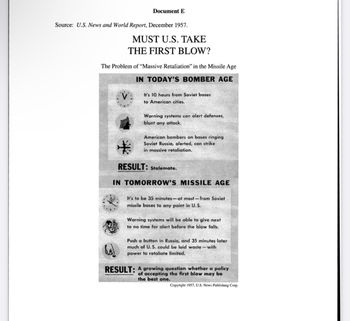Question
Explain this document

Transcribed Image Text:Document E
Source: U.S. News and World Report, December 1957.
MUST U.S. TAKE
THE FIRST BLOW?
The Problem of "Massive Retaliation" in the Missile Age
IN TODAY'S BOMBER AGE
V
It's 10 hours from Soviet bases
to American cities.
Warning systems can alert defenses,
blunt any attack.
American bombers on bases ringing
Soviet Russia, alerted, can strike
in massive retaliation.
RESULT: Stalemate.
IN TOMORROW'S MISSILE AGE
It's to be 35 minutes-at most-from Soviet
missile bases to any point in U.S.
Warning systems will be able to give next
to no time for alert before the blow falls.
Push a button in Russia, and 35 minutes later
much of U.S. could be laid waste - with
power to retaliate limited.
RESULT: A growing question whether a policy
of accepting the first blow may be
the best one.
Copyright 1957, U.S. News Publishing Corp.
Expert Solution
This question has been solved!
Explore an expertly crafted, step-by-step solution for a thorough understanding of key concepts.
This is a popular solution
Trending nowThis is a popular solution!
Step by stepSolved in 2 steps
